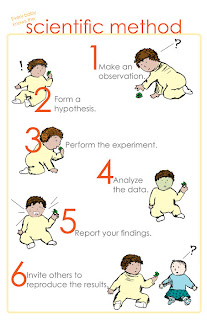Yesterday Sze Huei Yek over at
Rebelle Society wrote a thought-provoking article taking yogis to task for
"pseudoscience speeches." She basically argues that while she has personally benefited from her yoga, yogis should be mindful of the claims they make about the practice as a whole. Those claims, Yek worries, simply are not valid--at least not in the world of science where valid claims are based on observation, hypothesis, and experimentation in statistically controlled situations. It's that distinction, that willingness to remind folks that science has its own set of rules and procedures that makes me wish I could bake Ms. Yek cookies!
I only keep a toe in the world of yoga, but I see the same problematic tendency toward pseudoscience in the pagan community. Paganism was my entry point into meditation, breath work, and energy work, which are also common practice in yoga. Paganism came with a history and worldview that frequently clashes with the history and worldview that I honor as an intellectual, an experience that I imagine intellectual yogis struggle with as well.
For years I experienced this strange, often surreal divide between what I think of as my Academic Self and my Witchy Self. As my Academic Self I sorted through peer-reviewed journals, formed structured arguments, and marshaled both evidence and logic to support my claims. I lived in a world where I prided myself on thinking deeper, challenging assumptions, and demanding proof. Though my writing processes remained intuitive and alchemic, the work was intellectual and belonged to the respectable world of academic. As my Witchy Self I traded scholarly journals for bonfire chants where I channeled the knowledge of my ancestors. I still tried to think deeper, but the only proof was experience and the assumptions that I challenged where the foundation on which that respectable academic world was built.
I learned to roll with it...kind of like code-switching, I suppose. I kept my worlds apart and capered like Coyote Woman between the intellectual and intuitive worlds.
Until the day I recognized one of my professors from a pagan festival. I felt oddly outed, like some kind of hippie-spy exposed in the sedated corridors of a rural Midwestern university. Or worse, I worried, perhaps I would unwittingly become the person who outed a respectable professional as a woman who danced with animal spirits.
I decided to keep my quiet and keep my world divided, but the conflict was officially exposed. As a mindful person, I knew that I had a problem when I cringed to hear this professor offhandedly mention goddesses. I knew I had a problem if there was alarm in my head screaming, "You can NOT talk about this here. This is embarrassing. This is wrong. Everyone will think you're silly!"
However, I did not sing or pray to solve my problem. I read. I reread Wicca 101 books, I hosted a handful of pagan circles where we discussed spirituality, and I tracked down Ronald Hutton's
Triumph of the Moon: A History of Modern Pagan Witchcraft.
The process allowed me to see that my conflict wasn't rooted in an inherent conflict between the worlds of academic and intuitive experience, nor an inherent conflict between science and religion, nor the incompatibility of being pagan and knowing a bit about history. The problem lay in refusing to call apples “apples” and oranges “oranges“. The problem was pseudoscience.
For example, let's take the basic claim, "Wicca is a valid religion." Too often modern pagans attempt to validate their faith by arguing that it's an ancient religion. It's not. It was created in the 1950s by
Gerald Gardner. It was undoubtedly inspired by Gardner's interpretation of ancient history and ancient history is undoubtedly filled with goddesses, symbols, and stories that are worth exploring today. However, Wicca itself, as both a label and a practice came out of the mid-twentieth century. To claim otherwise is to repeat the problem many pagans accuse Christians of having: attempting to pass mythology-tradition as history.
I also believe that making false claims about Wicca’s history does the religion a dreadful disservice. The world doesn't need more "old" religions rooted in outdated worldviews and rituals. The world needs new world-views that embrace what humanity has learned over the centuries about science, sociology, and living in a diverse, humane society. The more we are willing to learn about history and science, the more we know about the realities that exist beyond the traditional borders of academia. The more we learn, the more we can do to validate practices and beliefs that flourish outside the accepted world-view.

Similarly, when pagans and yogis make their claims from within their tradition, they work to validate that tradition as its own body of knowledge. Not everything can be proven with science. Nor does it need to be. Therefore, I believe we do better work when we make claims like, "Kryia yoga teaches...." or "Modern pagans are inspired by ancient religions that believed...."
There are valid paths to knowledge beyond the rules of peer review and scientific method. However, I think it’s misguided and sometimes deceitful to try to pass one of those methods off as science. It’s that mislabeling–that “pseudoscience” babble that’s invalidating–not necessarily the claim itself.
As a society we're all struggling to balance intuitive experience with a mechanical, scientific world-view. However, it's a mistake to convolute personal experience with scientific study and make false claims about the history of a religion or the effects of breathing through the left nostril. Doing so just makes for poor science. However, when we embrace practices like yoga and Wicca as distinctive branches of knowledge and tradition, they flourish. It may not be science, but it is good.



































.jpg)
